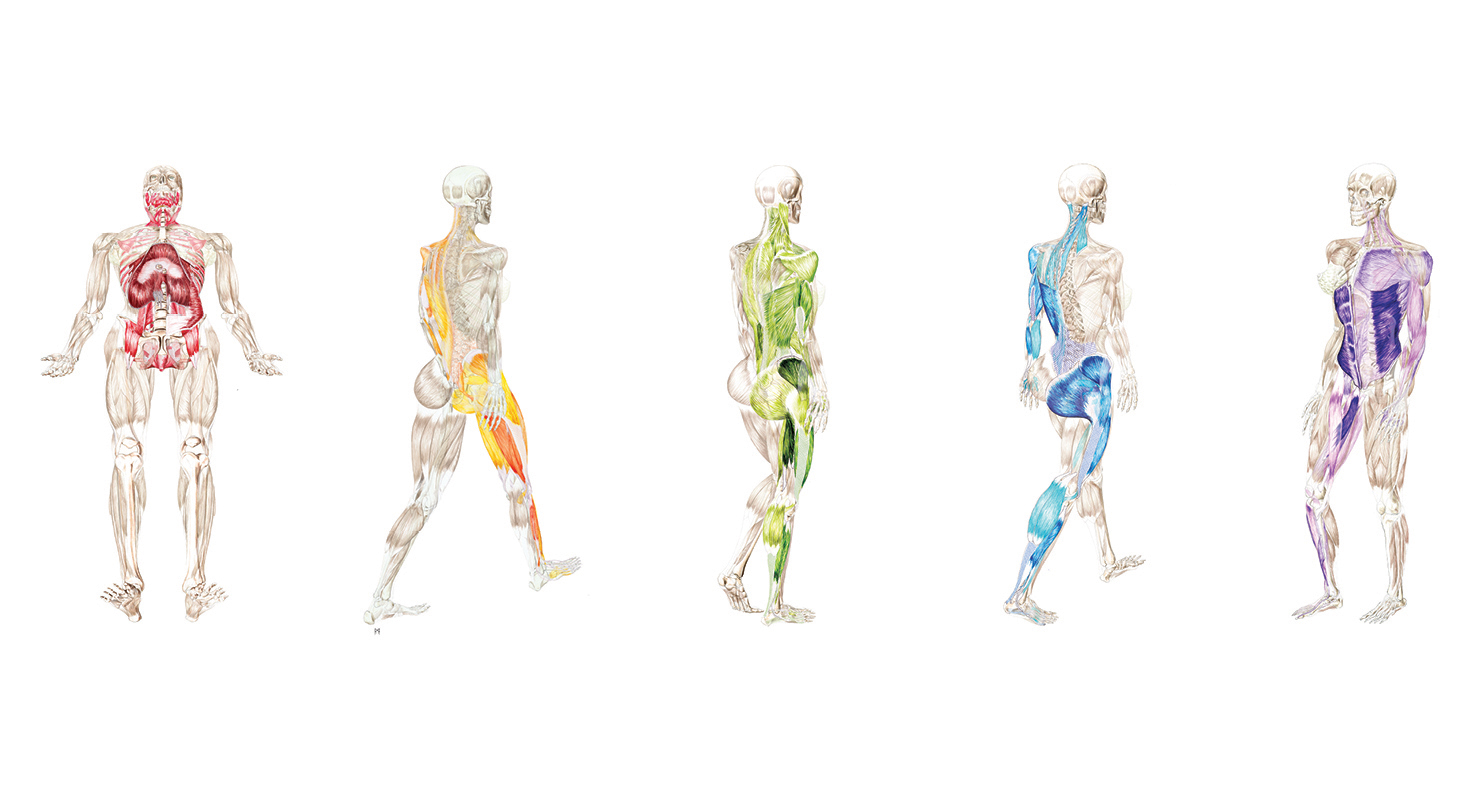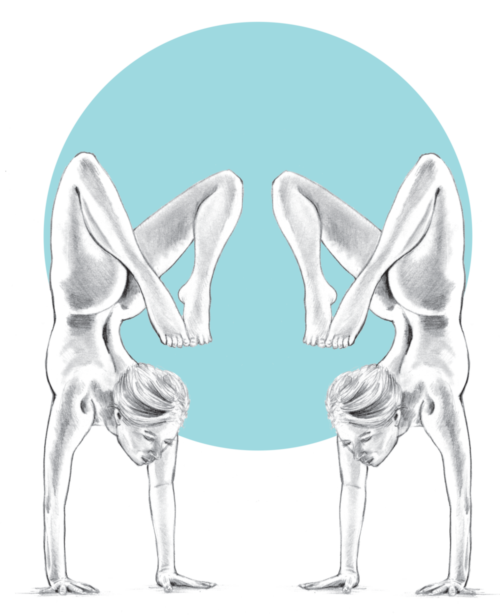
The Master Template



The charts in the Five Primary Kinetic Chains Anatomy Poster Series outline a primary physiological principle in movement: bones, joints, ligaments, tendons, muscles and fascia do not work in isolation. They work synergistically to create movement.
When movement is balanced and efficient, the players are all cooperating with each other. If movement is out of balance and inefficient, the result is compensation in the structure. This maladaptive compensation follows some specific physiological principles.
The first of these principles, synergistic dominance, is when one synergistic component of the structure is compensating for another synergistic component. More specifically, one component is overworked or up-regulated in relationship with another synergist that is underworked or down-regulated.
Synergistic dominance can show up over a spectrum of compensatory strategies. It can show up locally or globally. A local example would be the relationship of a muscle to itself. The distal end of a muscle can be up-regulated for a down-regulated proximal end of the same muscle. Synergist dominance will also show up when multiple muscles are working together. For example, hip flexion has several muscles that work synergistically. The iliacus, psoas, tensor fasciae latea, rectus femoris, adductor longus, and sartorious are the major contributors to hip flexion. If one of these muscles is up-regulated, that can functionally down-regulate the others.
Synergistic dominance also shows up globally. Kinetic chains, the manner in which the musculoskeletal system organizes itself, is not merely a local occurrence. Kinetic chains organize across the entire fascial fabric. The lateral kinetic chain provides a good example of global synergistic dominance. Throughout the dynamic platform of the stance phase of the gait, the ankle, pelvis, torso, and neck all need to play well together. If they are unable to do so, then one player will take over doing the job of the player unable to engage. Single leg stance is a great global assessment protocol to discern synergistic dominance of the lateral kinetic chain.
Synergistic dominance can also show up in kinetic chains that work in unison. For example, during the gait cycle, the posterior spiral kinetic chain is paired with the opposite deep longitudinal kinetic chain. Likewise, the lateral kinetic chain is paired with the opposite anterior spiral kinetic chain. These pairings of kinetic chains have an interdependent relationship. One relies on the other in the efficiency of storing and releasing elastic energy. If one chain has a dysfunctional component, it is going to have an effect on the other, they are in a synergistic relationship.
The other side of the synergist coin is the functional opposite. Muscles that work in opposition to one another rely on a principal called reciprocal inhibition. Reciprocal inhibition defines that the agonist, contracts or shortens, as the opposite, the antagonist, must lengthen. Simply, if one muscle is shortening then the other must be lengthening. If the muscle that should be lengthening is unable to do so, the effect is that the muscle that needs to shorten becomes down-regulated. It is unable to overcome the up-regulated muscle, as it can’t compete.
Functional opposites happen across kinetic chains just as synergists do. The foundation of understanding synergistic dominance builds the prerequisite for investigating functional opposites. As movement evolves, essentially there are two things happening: some tissues are shortening while others are lengthening.
The charts included in The 5 Primary Kinetic Chains posters provide a map for synergistic relationships. By mapping the synergists, one can then decode functional opposites. This is a very useful learning tool as well as a visual reference for your clients and patients.

Let me introduce to you a key muscle that is highly noteworthy and receives a lot of well-deserved attention called the psoas. This muscle supports the musculoskeletal system through several important functions.
The psoas is a multisegment muscle, as it crosses multiple joints from the thoracic lumbar junction through each lumbar vertebrae. The psoas connects the axis of the spine to the appendicular function of the hip. In other words, the psoas attaches the trunk to the thigh.
The attachment on the thigh, the lessor trochanter, gives the psoas mechanical advantage in external rotation of the hip. The psoas is a lumbar stabilizer, a hip flexor, and is also a synergist in the breathing apparatus.
The psoas is central to movement stability.
Muscles that cross single joints, and are short by design, are hardworking dependable muscles. The nervous system can count on these muscles in recruitment and compensation patterns. However, muscles that cross multiple joints don’t have as much mechanical leverage (longer lever equates to more load on the fibers). What they are good at is providing dynamic stability while the shorter, hardworking muscles provide the power.
In the case of hip flexion, the function of the psoas is stabilization of the lumbar while its synergist, the iliacus, is the power generator.
The psoas is a multi-planer stabilizer that works in a three-dimensional context.
The psoas likes to work with its favorite partner in lumbar stabilization, the quadrates lumborum,(QL). The QL has a fascial compartment just posterior of the psoas. The compartments need to have the capacity to glide across one another so discreet function can happen in the sagittal, coronal and transverse planes. In sagittal plane movement the psoas and QL work in ipsilateral pairs on the same side. This is also true for the coronal plane. Though in the coronal plane, while one side is shortening, the opposite side is lengthening. This is called lateral flexion. The function of the psoas in the transverse plane is related to the walking gait. The transverse plane pairing is contralateral. One side of the psoas is working with the opposite side QL to stabilize the lumbar as the pelvis is moving around the axis of the spine.
The psoas is a primary compartment of the greater lumbodorsal fascia. This fascial sheath connects the torso to the pelvis so that the action of the appendicular skeleton and axial skeleton wind-up and release elastic energy throughout the cycle of the walking gait.
One really can’t talk about the psoas without mentioning its relationship to the breathing apparatus. The psoas is a key player in the spinal wave: the action that assists the cerebrospinal fluid pump. Further, the psoas shares connective tissue with the thoracic diaphragm. This is significant because when the psoas doesn’t play well with the breathing apparatus, the autonomic nervous system’s sympathetic arousal stays up-regulated. This cascade of chemistry from the sympathetic response hijacks the nervous system’s ability to cope. Said another way it results in stress. (Click here to see the video: http://www.youtube.com/watch?v=9JqFWUjxI1Q&app=desktop)

All movement leads to adaptation creating compensation.
The law of adaptation: The organism adapts to its environment regardless of outcome. The nervous system does not differentiate whether an adaptation is beneficial or not.
I have seen several clients over the years, seasoned yoga practitioners, that had a similar root problem with different outcomes. The problem was a recruitment pattern with the toes. The instruction to “floint” the foot is to flex the toes while pointing the forefoot. This is also known as “Barbie Feet.”
Compensation in the toes creates global compensation patterns. These patterns occur along front and back kinetic chains. Kinetic chains can be understood as muscles that link together to create integration. When one muscle becomes inhibited, the chain is broken. This results in some muscles that are overworked, and others that are underworked. When the toe flexors become dominate, two different patterns can emerge.
Patterns of inhibition along the same kinetic chain as the toe flexors, along the front of the body are known as synergists. One client had pain just below her hip joint in the front of her thigh. The hip flexors were inhibited by her toe flexors. Every step she took exasperated the problem. Another client had pain in the back of her thigh. She had patterns of inhibition along the back of the body. This pattern is the functional opposite to the toe flexors.
There are other groups of people that have kinetic chain imbalances due to toe flexor dominance. People that wear high heels and/or flip flops are also high risk.
Whatever activity we regularly do, will unknowingly create undesirable movement patterns. Fortunately, undesirable patterns are learned behavior. Thus, they can be unlearned and replaced by a more desirable pattern.